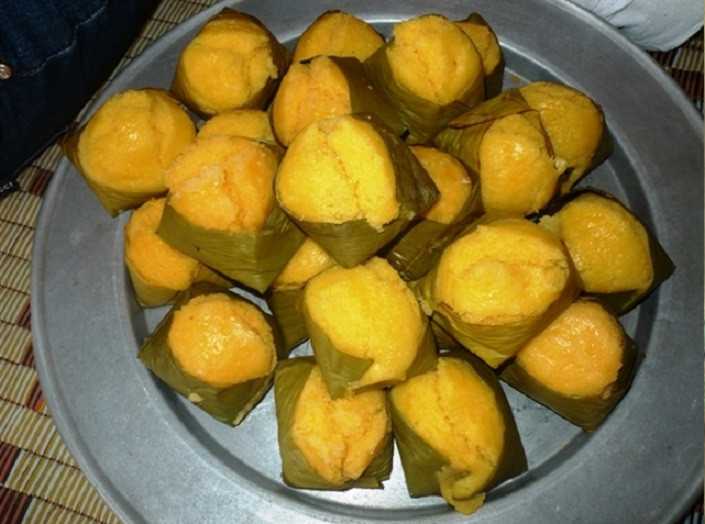
A popular dish across western provinces, particularly of An Giang’s Châu Đốc District, this special cow cake is cooked with palmyra palm sugar and is a point of pride among locals here. Fermented glutinous rice and coconut juice give the cake its signature buttery rich characteristics.
The beautiful southern coastal province of An Giang is famous for not only its attractive tourism sites such as the Mubarak Islamic Mosque and Núi Sam (Sam Mountain) Cable Car, but also bánh bò thốt nốt (palm sugar honeycomb cake), a must-try specialty when visiting this area.
Bánh bò thốt nốt is a sweet, chewy sponge cake. It is made from rice flour, water, palmyra palm sugar and yeast, and has a honeycomb-like texture.
A popular dish across western provinces, particularly of An Giang’s Châu Đốc District, this special dessert is cooked with palmyra palm sugar and is a point of pride among locals here.
Its special name in Vietnamese "bánh bò" meaning "cow cake" – is derived from its shape, which resembles a cow's udder. However, according to a popular folk explanation, bò also refers to how the cake "crawls" up to the rim of the bowl when fully steamed.
The dessert originates from southern China, however its Chinese version does not contain coconut milk. There are several varieties with different shape, ingredients and method of preparation, like baked, steamed or milk bánh bò, but all of them have the characteristic airy texture like a honeycomb.
Ingredients of the cake include special rice, locally known as Nàng When, and palmyra palm, of which the thick inside is ground into powder, while the palmyra palm sugar should be pure, unadulterated with any other substance.
Fermented glutinous rice and coconut juice is also needed to give the cow cake its signature buttery rich characteristics, said local cook Huỳnh Thị Lý, 70.
She said the cake is a very filling dish because it consists of abundant carbohydrates and saturated fats. “The cake can be used as a breakfast, desert, or eaten with grilled pork.”
Locals are interested in the cake so much because it is tasty, nutritious and affordable, while visitors are advised to buy it as a gift for their relatives back home, Lý said.
Making the cake requires special care, said Lý, noting that the secret to create the cake’s genuine characteristics is how to mix the fermented rice water with Nàng When rice powder, boil down the sugar and steam it.
All of the above-mentioned ingredients should be fermented for a day before putting them into square or round frame 3cm thick, steam it for 20 minutes then spread coconut juice over it and top it with coconut threads. It is often covered with banana leaf or soong, wild leaves that grow only in Châu Đốc, Lý told Việt Nam News.
It is a valuable dish to offer honoured guests and an indispensable cake for big parties at Tết (Lunar New Year) holiday.
It can be preserved in refrigeration for 3-4 days use, she said.
Lương Ngọc Bình, a visitor from Hà Nội, said the attractive aroma of the cake can be detected all over the district, making it hard for any visitor to resist.
“I’ve heard about the cake for a long time. I thought it was a normal treat, until recently when I tried it and found it an unforgettable cake. It is soft, light and sweet from the palmyra palm, with a rich buttery taste from coconut,” Bình said.
He said the cakes are sold throughout Châu Đốc District and An Giang Province, but to buy the best one you should visit Bánh Bò Út Dứt at 13 Nguyễn Thị Minh Khai, Long Thạnh Ward of An Giang’s Tân Châu Town, or Ha Cô grilled cow cake shop in Châu Phong Hamlet of Tân Châu Town where diners can experience grilling the cake themselves. — VNS